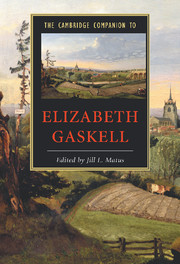Book contents
- Frontmatter
- 1 Introduction
- 2 The life and letters of E. C. Gaskell
- 3 Mary Barton and North and South
- 4 Cranford and Ruth
- 5 Elizabeth Gaskell’s The Life of Charlotte Brontë
- 6 Sylvia’s Lovers and other historical fiction
- 7 Cousin Phillis, Wives and Daughters, and modernity
- 8 Elizabeth Gaskell’s shorter pieces
- 9 Gaskell, gender, and the family
- 10 Elizabeth Gaskell and social transformation
- 11 Unitarian dissent
- 12 Gaskell then and now
- Guide to further reading
- Index
- Series List
5 - Elizabeth Gaskell’s The Life of Charlotte Brontë
Published online by Cambridge University Press: 28 May 2007
- Frontmatter
- 1 Introduction
- 2 The life and letters of E. C. Gaskell
- 3 Mary Barton and North and South
- 4 Cranford and Ruth
- 5 Elizabeth Gaskell’s The Life of Charlotte Brontë
- 6 Sylvia’s Lovers and other historical fiction
- 7 Cousin Phillis, Wives and Daughters, and modernity
- 8 Elizabeth Gaskell’s shorter pieces
- 9 Gaskell, gender, and the family
- 10 Elizabeth Gaskell and social transformation
- 11 Unitarian dissent
- 12 Gaskell then and now
- Guide to further reading
- Index
- Series List
Summary
Before The Life: nineteenth-century women’s biography
Charlotte Brontë died on March 31, 1855, and when Elizabeth Gaskell learned of her death, she resolved to write a memoir of her friend and fellow-novelist. On May 31, 1855, she wrote to Bronte's publisher, George Smith of Smith, Elder: ''if I live long enough, and no one is living whom such a publication would hurt, I will publish what I know of her, and make the world (if I am but strong enough in expression,) honour the woman as much as they have admired the writer'' (L, 345). The opportunity came sooner than Gaskell expected. On June 16, 1855, the Reverend Patrick Brontë, Charlotte's father, addressed a letter to Gaskell, with a request for her “to write a brief account of her life and to make some remarks on her works''; he added: ''You seem to me to be the best qualified for doing what I wish should be done.”
When Gaskell agreed to write a biography of Brontë, the models for a woman author's life were few, and none distinguished. Alexander Dyce had published Specimens of British Poetesses (1825) and Anne Katherine Elwood Memoirs of the Literary Ladies of England (1843), the first an anthology of representative poems with biographical headnotes, the second a collection of short biographies describing each author's life circumstances and chief literary works. Both were informational, the second inspirational to aspiring young women. As Elwood acknowledged in her preface, her Memoirs were for the amateur, “intended only for such of her own sex, who, not feeling themselves equal to profound and abstract subjects, can derive amusement and information from what is professedly too light for the learned, and too simple for the studious.”
- Type
- Chapter
- Information
- The Cambridge Companion to Elizabeth Gaskell , pp. 59 - 74Publisher: Cambridge University PressPrint publication year: 2007
- 2
- Cited by

